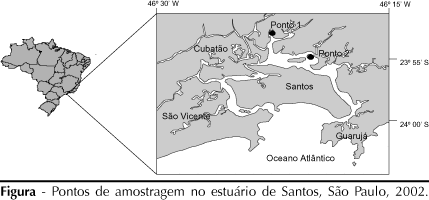OBJECTIVE: To develop a strategy for water quality monitoring for the presence of genotoxins and polycyclic aromatic hydrocarbons. METHODS: A study was carried out in Santos estuary, Southern Brazil, in 2002. Two sampling sites with different concentration levels were selected and evaluated in different samplings using blue rayon hanging technique, chemical analyses, and Salmonella/microsome assay with bacterial strains sensitive to different compounds. The extracts were tested using the Salmonella/microsome assay in microsuspension with the strains TA98, TA100, YG1041, and YG1042 in the absence and presence of metabolic activation and through chemical analyses. RESULTS: Site 1, which had high concentrations of polycyclic aromatic hydrocarbons in its sediment, showed more often positive results in the Salmonella/microsome assay as well as higher polycyclic aromatic hydrocarbons concentrations in both samplings compared to site 2, which was less contaminated. YG1041 strain showed to be the most sensitive allowing for comparisons between the sites with different levels of contamination. CONCLUSIONS: The combination of the blue rayon hanging technique with the Salmonella/microsome assay using YG1041 strain and chemical analyses were effective in recovering genotoxins as well as polycyclic aromatic hydrocarbons tested in this study. Therefore this strategy seems to be adequate for water quality monitoring in Santos estuary.
Estuary pollution; Water monitoring; Polycyclic hydrocarbons, aromatic; Blue rayon; Salmonella/microsome; Santos estuary





